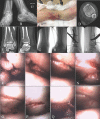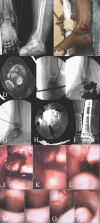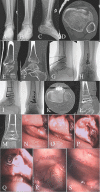Needle Arthroscopy as a Reduction Aid for Lower Extremity Peri-Articular Fractures: Case Series and Technical Tricks
- PMID: 37383858
- PMCID: PMC10296474
Needle Arthroscopy as a Reduction Aid for Lower Extremity Peri-Articular Fractures: Case Series and Technical Tricks
Abstract
Background: Intra-articular fractures represent a challenging group of injuries that can occur in many different locations. In addition to restoring the mechanical alignment and stability of the extremity, accurate reduction of the articular surface is a primary goal for the treatment of peri-articular fractures. A variety of methods have been deployed to assist in the visualization and subsequent reduction of the articular surface, each with a unique set of pros and cons. The ability to visualize the articular reduction must be balanced against the soft tissue trauma required for extensile exposures. Arthroscopic assisted reduction has gained popularity for the treatment of a variety of articular injuries. Recently, needle based arthroscopy has been developed, predominantly as an outpatient tool for the diagnosis of intra-articular pathology. We present an initial experience with and technical tricks for the use of a needle based arthroscopic camera in the treatment of lower extremity peri-articular fractures.
Methods: A retrospective review of all cases where needle arthroscopy was used as a reduction adjunct in lower extremity peri-articular fractures at a single, academic, level one trauma center was performed.
Results: Five patients with six injuries were treated with open reduction internal fixation with adjunctive needle based arthroscopy. Early experience and tips and tricks for successful utilization of this technique are presented.
Conclusion: Needle based arthroscopy may represent a valuable adjunct in the treatment of peri-articular fractures and warrants further investigation. Level of Evidence: IV.
Keywords: arthroscopic assisted reduction; articular fracture; needle arthroscopy.
Copyright © The Iowa Orthopaedic Journal 2023.
Figures






References
-
- Dei Giudici L, Di Muzio F, Bottegoni C, Chillemi C, Gigante A. The role of arthroscopy in articular fracture management: the lower limb. Eur J Orthop Surg Traumatol. 2015;25(5):807–13. - PubMed
-
- Hamilton GA, Doyle MD, Castellucci-Garza FM. Arthroscopic-Assisted Open Reduction Internal Fixation. Clin Podiatr Med Surg. 2018;35(2):199–221. - PubMed
-
- Ono A, Nishikawa S, Nagao A, Irie T, Sasaki M, Kouno T. Arthroscopically assisted treatment of ankle fractures: arthroscopic findings and surgical outcomes. Arthroscopy. 2004;20(6):627–31. - PubMed
-
- Chen XZ, Chen Y, Liu CG, Yang H, Xu XD, Lin P. Arthroscopy-Assisted Surgery for Acute Ankle Fractures: A Systematic Review. Arthroscopy. 2015;31(11):2224–31. - PubMed
-
- Egol KA, Cantlon M, Fisher N, Broder K, Reisgo A. Percutaneous Repair of a Schatzker III Tibial Plateau Fracture Assisted by Arthroscopy. J Orthop Trauma. 2017;3(31 Suppl):S12–S3. - PubMed
MeSH terms
LinkOut - more resources
Full Text Sources
Medical
Miscellaneous
